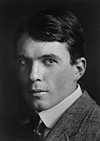Sir William Lawrence Bragg
 William Lawrence Bragg, son of William Henry Bragg, Elder Professor of Mathematics and Physics at Adelaide University, was born in Adelaide on 31 March 1890. He received his early education at St Peter's College proceeding to Adelaide University at the age of 14 to take a degree in mathematics with first-class honours in 1908. He went to England with his father in 1909 and entered Trinity College Cambridge as an Allen Scholar and gained first-class honours in the Natural Science Tripos in 1912.
From 1912 to 1914 he worked with his father, and the results of their work on X-rays and Crystal Structure was published in 1915 earning them jointly the Nobel Prize for Physics in the same year. In the case of the son, he is the youngest-ever Nobel laureate.
Bragg enlisted in the 58th Brigade Royal Field Artillery and developed a system of locating enemy batteries by measuring sound frequencies of incoming artillery shells. He was awarded the Military Cross and mentioned in Dispatches.
In 1948 Fred Watson and James Crick approached Lawrence Bragg to interpret an x-ray of molecules that he identified as being a helix that led to the discovery of the structure of DNA and their admission as Nobel Laureates in 1951.
Lawrence Bragg was elected Fellow of the Royal Society in 1921, he was Director of the National Physical Laboratory in 1937-1938 and Cavendish Professor of Experimental Physics, Cambridge, from 1938 to 1953. He was Chairman of the Frequency Advisory Committee from 1958 to 1960. He was knighted in 1941.
William Lawrence Bragg died 1 July 1971 Ipswich survived by his wife, two sons and two daughters and was buried in Trinity College Chapel in Cambridge. While his adult life was spent outside South Australia he certainly began his work whilst in Adelaide.
|